

Action research. Beginner's Guide to Text Mining (2) A Beginner's Guide to Text Mining — SAGE Campus - Online Data Science Courses for Social Scientists from Sage Publishing. Uk.sagepub. Five Misunderstandings About Case-Study ResearchQualitative Inquiry - Bent Flyvbjerg, 2006. MB 108 e. Subjects matches any of "6.1 Social Network Analysis" - NCRM EPrints Repository. Subjects matches any of "6.1 Social Network Analysis" Displaying results 1 to 20 of 24.Refine search | New search | 1 | 2 | Next Order the results:
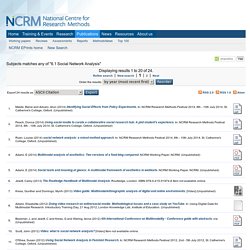
Subjects matches any of "6. Mixed Methods Data Handling and Data Analysis" - NCRM EPrints Repository. Subjects matches any of "4.2 Interaction Analysis" - NCRM EPrints Repository. Subjects matches any of "4.2 Interaction Analysis" Displaying results 1 to 20 of 30.Refine search | New search | 1 | 2 | Next Order the results:
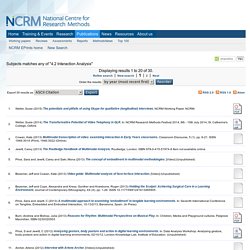
Subjects matches any of "5.9 Spatial Data Analysis" - NCRM EPrints Repository. Analysing gesture, body posture and action in digital learning environments - NCRM EPrints Repository. An introduction to researching embodiment in digital learning environments. This seminar, organised as part of the NCRM MODE node, will examine how embodiment is understood and researched within digital technologies (e.g. tangible, sensor, mobile) with a focus on three themes: 1) physical manipulation through tangible technologies; 2) context-based interaction through mobile devices; and 3) whole-body physical action through sensor-based technologies.
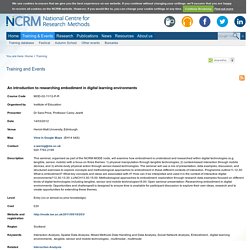
The seminar will use a mix of presentation, data examples, discussion, and structured exercises to explore concepts and methodological approaches to embodiment in these different contexts of interaction. Programme outline11-12.30: What is embodiment? What key concepts and ideas are associated with it? How can it be interpreted and used it in the context of interactive digital environments? Faste. What is VTS? - Visual Thinking Strategies. Research - Research Methods - Visual Thinking Strategies. Abigail Housen: An Empirical Approach Abigail Housen began in the mid-1970s to try to understand how varying degrees of exposure to viewing works of art affected people's viewing experiences.
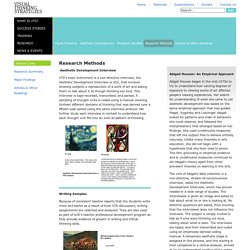
Her search for understanding of what she came to call aesthetic development was based on the same empirical approach that had guided Piaget, Vygotsky and Loevinger. Abigail looked for patterns and order in behaviors she could observe, and followed the interpretations that emerged based on her findings. She used unobtrusive measures that left the subject free to behave entirely naturally. Unlike many theorists in arts education, she did not begin with a hypothesis that she then tried to prove.
The core of Abigail's data collection is a non-directive, stream-of-consciousness interview, called the Aesthetic Development Interview, which has proven reliable in a wide range of studies. Watch Life Off Grid Online. Humankinetics. Research Methods in Physical Activity, Seventh Edition, systematically guides students through the research process, introducing methods and tools specifically for kinesiology and exercise science disciplines, including the subdisciplines of physical therapy, rehabilitation, and occupational therapy.
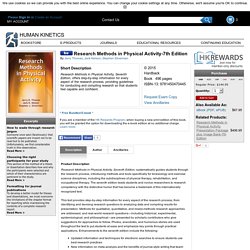
The seventh edition leads students and novice researchers to research competency with the distinctive humor that has become a trademark of this internationally recognized text. This text provides step-by-step information for every aspect of the research process, from identifying and devising research questions to analyzing data and compiling results for presentation. Methods for qualitative, quantitative, and mixed-methods research approaches are addressed, and real-world research questions—including historical, experimental, epidemiological, and philosophical—are presented by scholarly contributors who give suggestions for approaches to follow. Preface Study Tips Acknowledgments Summary. How to Do a Visual Analysis. One of the best ways to improve visual literacy and visual communication skills is to analyze a visual artifact of some kind.
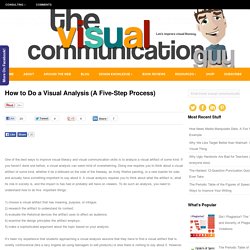
If you haven’t done one before, a visual analysis can seem kind of overwhelming. Doing one requires you to think about a visual artifact of some kind, whether it be a billboard on the side of the freeway, an Andy Warhol painting, or a new toaster for sale, and actually have something important to say about it. A visual analysis requires you to think about what the artifact is, what its role in society is, and the impact is has had or probably will have on viewers. To do such an analysis, you need to understand how to do five important things: 1) choose a visual artifact that has meaning, purpose, or intrigue; 2) research the artifact to understand its context; 3) evaluate the rhetorical devices the artifact uses to affect an audience; 4) examine the design principles the artifact employs; 5) make a sophisticated argument about the topic based on your analysis.
When to Use Which User-Experience Research Methods.